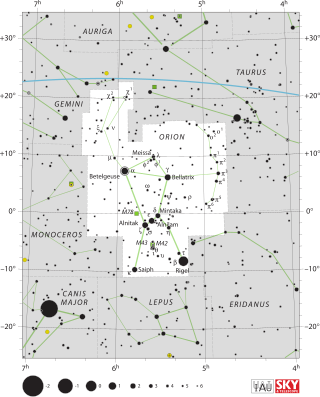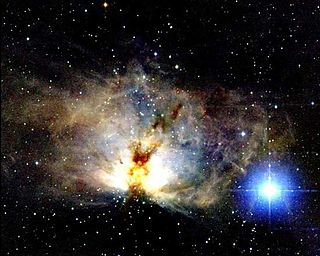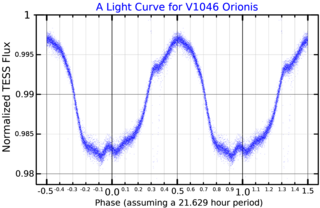
Saiph, designation Kappa Orionis and 53 Orionis, is the sixth-brightest star in the constellation of Orion. Of the four bright stars that compose Orion's main quadrangle, it is the star at the south-eastern corner. A northern-hemisphere observer facing south would see it at the lower left of Orion, and a southern-hemisphere observer facing north would see it at the upper right. Parallax measurements yield an estimated distance of 650 light-years from the Sun, which is about the same as Betelgeuse. It is smaller, less luminous but hotter at its surface than Rigel with an apparent visual magnitude of 2.1. The luminosity of this star changes slightly, varying by 0.04 magnitudes.

Alnilam is the central star of Orion's Belt in the equatorial constellation of Orion. It has the Bayer designation ε Orionis, which is Latinised to Epsilon Orionis and abbreviated Epsilon Ori or ε Ori. This is a massive, blue supergiant star some 2,000 light-years distant. It is estimated to be 832,000 times as luminous as the Sun, and 64.5 times as massive.

Bellatrix is the third-brightest star in the constellation of Orion, positioned 5° west of the red supergiant Betelgeuse. It has the Bayer designation γ Orionis, which is Latinized to Gamma Orionis. With a slightly variable magnitude of around 1.6, it is typically the 25th-brightest star in the night sky. Located at a distance of 250±10 light-years from the Sun, it is a blue giant star around 7.7 times as massive as the sun with 5.75 times its diameter.

Alnitak is a triple star system in the constellation of Orion. It has the designations ζ Orionis, which is Latinised to Zeta Orionis and abbreviated Zeta Ori or ζ Ori, and 50 Orionis, abbreviated 50 Ori. The system is located at a distance of several hundred parsecs from the Sun and is one of the three main stars of Orion's Belt along with Alnilam and Mintaka.

Iota Orionis is a multiple star system in the equatorial constellation of Orion the hunter. It is the eighth-brightest member of Orion with an apparent visual magnitude of 2.77 and also the brightest member of the asterism known as Orion's Sword. It is a member of the NGC 1980 open cluster. From parallax measurements, it is located at a distance of roughly 1,340 light-years from the Sun.

Pi3 Orionis (π3 Orionis, abbreviated Pi3 Ori, π3 Ori), also named Tabit, is a star in the equatorial constellation of Orion. At an apparent visual magnitude of 3.16, it is readily visible to the naked eye and is the brightest star in the lion's hide (or shield) that Orion is holding. As measured using the parallax technique, it is 26.32 light-years (8.07 parsecs) distant from the Sun.

The Orion molecular cloud complex is a star-forming region with stellar ages ranging up to 12 Myr. Two giant molecular clouds are a part of it, Orion A and Orion B. The stars currently forming within the complex are located within these clouds. A number of other somewhat older stars no longer associated with the molecular gas are also part of the complex, most notably the Orion's Belt, as well as the dispersed population north of it. Near the head of Orion there is also a population of young stars that is centered on Meissa. The complex is between 1 000 and 1 400 light-years away, and hundreds of light-years across.

Eta Orionis or Algjebbah, Latinized from η Orionis, is a multiple star in the constellation Orion. It lies a little to the west of Orion's Belt between Delta Orionis and Rigel, being closer to Delta Orionis than to Rigel. It lies at a distance of around 1,000 light-years from Earth and is part of the Orion OB1 association.

Sigma Orionis or Sigma Ori is a multiple star system in the constellation Orion, consisting of the brightest members of a young open cluster. It is found at the eastern end of the belt, south west of Alnitak and west of the Horsehead Nebula which it partially illuminates. The combined brightness of the component stars is magnitude 3.80.

HD 37017 is a binary star system in the equatorial constellation of Orion. It has the variable star designation V1046 Orionis; HD 37017 is the identifier from the Henry Draper Catalogue. The system is a challenge to view with the naked eye, being close to the lower limit of visibility with a combined apparent visual magnitude of 6.55. It is located at a distance of approximately 1,230 light years based on parallax, and is drifting further away with a radial velocity of +32 km/s. The system is part of star cluster NGC 1981.

FU Orionis is a variable and binary star system in the constellation of Orion, that in 1937 rose in apparent visual magnitude from 16.5 to 9.6, and has since been around magnitude 9. The name FU Orionis is a variable star designation in the Argelander system, which are assigned sequentially as new variables are discovered. FU Orionis is about 1,360 light years distant and is associated with the molecular cloud Barnard 35.

The Lambda Orionis Cluster is an open star cluster located north-west of the star Betelgeuse in the constellation of Orion. It is about five million years old and roughly 1,300 ly (400 pc) away from the Sun. Included within the cluster is a double star named Meissa. With the rest of Orion, it is visible from the middle of August in the morning sky, to late April before Orion becomes too close to the Sun to be seen well. It can be seen from both the northern hemisphere and the southern hemisphere.

25 Orionis, less commonly known by its Bayer designation Psi1 Orionis is a fifth-magnitude star in the constellation Orion. It lies among a dense cluster of low-mass pre-main-sequence stars in the Orion OB1a.

Chi2 Orionis is a B-type supergiant star in the constellation of Orion. It has an apparent visual magnitude of 4.63 but being quite distant, and heavily extinguished it burns with the greatest absolute visual light magnitude among stars in Orion within the near reaches of the galaxy, 0.9 of a magnitude brighter than Rigel. Since 1943, the spectrum of this star has served as one of the stable anchor points by which other stars are classified. It is considered to be a member of the Gemini OB1 association.

Pi1 Orionis (π1 Ori, π1 Orionis) is a star in the equatorial constellation of Orion. It is faintly visible to the naked eye with an apparent visual magnitude of 4.74. Based upon an annual parallax shift of 28.04 mas, it is located about 116 light-years from the Sun.

69 Orionis is a single star in the equatorial constellation of Orion, positioned a couple of degrees to the north of Xi Orionis. It has the Bayer designation f1 Orionis; 69 Orionis is the Flamsteed designation. The star is visible to the naked eye as faint, blue-white hued point of light with an apparent visual magnitude of 4.92. It is located approximately 530 light-years from the Sun based on parallax, and is drifting further away with a radial velocity of +22 km/s. In 2015, H. Bouy and J. Alves suggested that it is a member of the newly discovered Taurion OB association.

Theta2 Orionis is a multiple star system in the constellation Orion. It is a few arc minutes from its more famous neighbour the Trapezium Cluster, also known as θ1 Orionis.
23 Orionis is a double star located around 1,200 light-years away from the Sun in the equatorial constellation of Orion. It is visible to the naked eye as a dim, blue-white-hued point of light with a combined apparent visual magnitude of 4.99. The pair are moving away from the Earth with a heliocentric radial velocity of +18 km/s, and they are members of the Orion OB1 association, subgroup 1a.

Phi1 Orionis is a binary star system in the constellation Orion, positioned less than a degree to the south of Meissa. It is visible to the naked eye with an apparent visual magnitude of 4.42. The distance to this system, based upon an annual parallax shift of 3.0 mas, is around 1,090 light-years.

UX Orionis is a variable star in the constellation of Orion. It is a Herbig Ae star, located about 1000 light years from the Earth. At its brightest it is a magnitude 9.5 object, so it is too faint to be seen with the naked eye. UX Orionis is the prototype of the UX Orionis class of variable stars, which are young stellar objects that exhibit large, irregular changes in visual band brightness. UX Orionis was discovered by Henrietta Swan Leavitt.











